Why Aaron Judge's 62nd Homer Gives Him MLB's All-Time Best Home Run Season
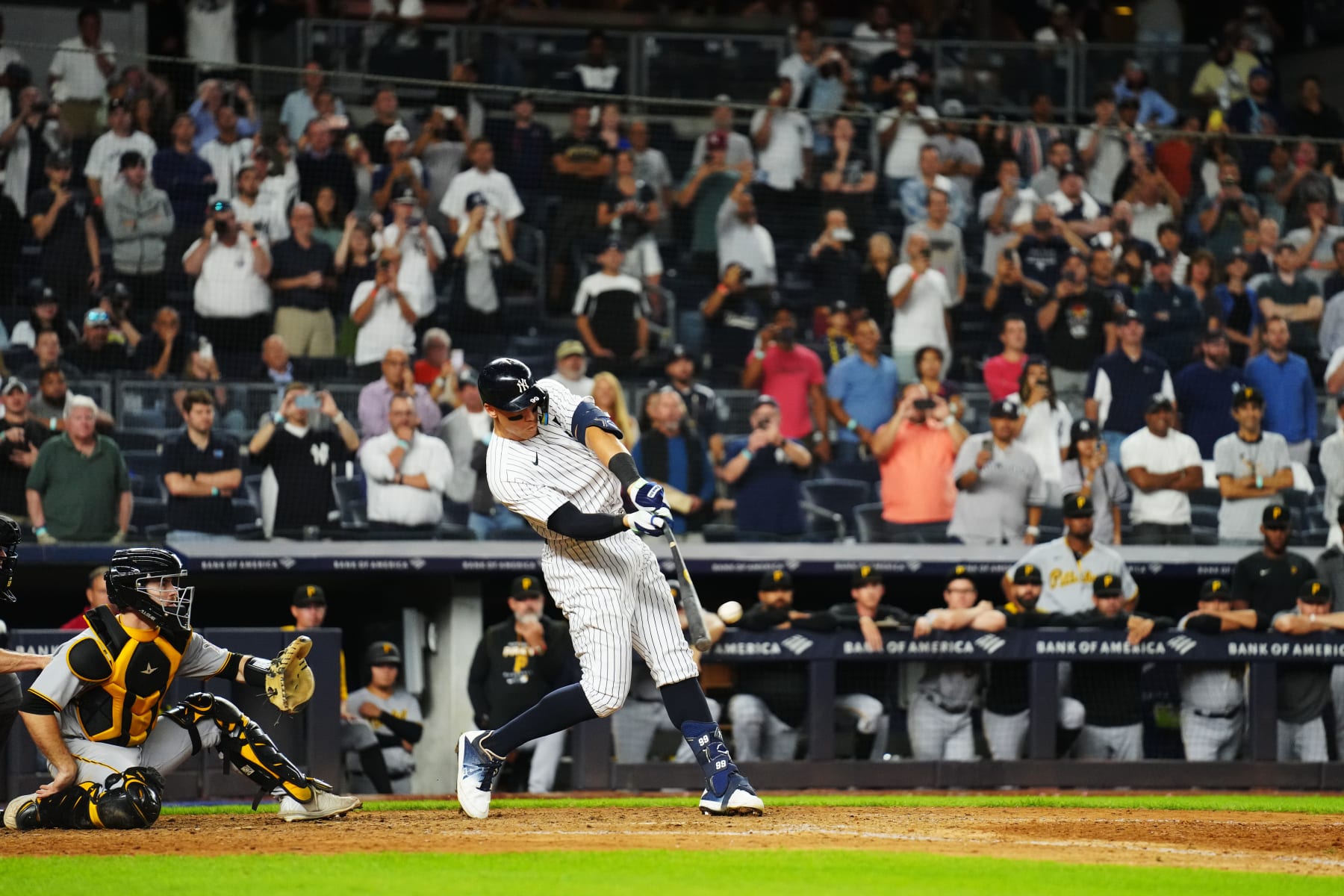
With 62 in the bag, New York Yankees slugger Aaron Judge is now the American League's all-time single-season home run champion. Some might also recognize him as the "real" or "true" single-season champ for all of Major League Baseball.
That's a no from us, but it is with zero reservations that we're about to argue for Judge's 2022 season as the most impressive entry in MLB's six-member 60 Home Run Club.
First things first, though. Or rather, 62nd things 62nd.
Having already matched Babe Ruth's old record of 60 from 1927 on Sept. 20 and Roger Maris' subsequent record of 61 from 1961 on Wednesday, it was on Tuesday that Judge finally claimed the all-time AL mark for himself. His 62nd home run was a 391-foot blast off Texas Rangers righty Jesus Tinoco:
Though Judge is still 11 home runs short of the MLB-record 73 that Barry Bonds hit in 2001, Roger Maris Jr. surely isn't alone in his refusal to validate Bonds' mark. After all, the era that contained not only Bonds' 2001 season but also Mark McGwire's 60-plus-homer efforts from 1998 and 1999 and Sammy Sosa's from '98, '99 and '01 can be fairly described as unusual.
The Other 60-HR Players Had Advantages
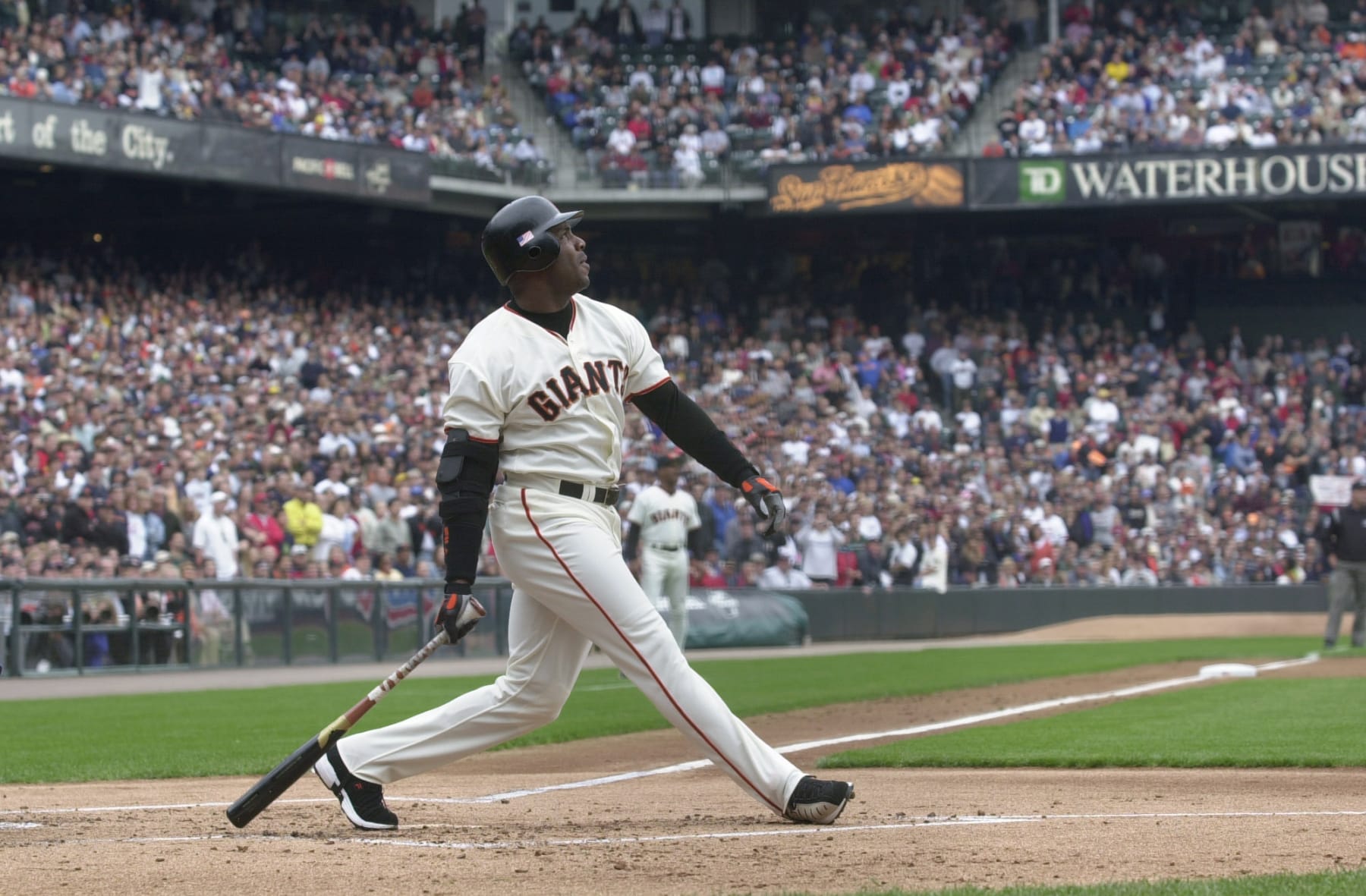
But do you know who doesn't want to hear it? Judge himself.
The Linden, California native and formerly self-professed San Francisco Giants fan has said on more than one occasion that he still holds Bonds' 73 blasts from '01 as MLB's real home run record, including in September in an interview with Tom Verducci of Sports Illustrated:
“Seventy-three is the record. In my book. No matter what people want to say about that era of baseball, for me, they went out there and hit 73 homers and 70 homers, and that to me is what the record is. The AL record is 61, so that is one I can kind of try to go after. If it happens, it happens. If it doesn’t, it’s been a fun year so far.”
Back before he was Judge's teammate on the Yankees, Giancarlo Stanton had a different take when he was making a run at 60 homers with the Miami Marlins in 2017. As he told Dave Hyde of the South Florida Sun Sentinel, "Considering some things, I do [believe 61 is the record]."
The blanks in Stanton's statement were and still are easy to fill. Bonds, McGwire and Sosa had their homer-hitting heydays during the heart of baseball's steroid era in the late 1990s and early 2000s. So even if MLB hasn't scrubbed their achievements from the record books, there's nonetheless a question about their legitimacy.
Perhaps all the more so given that all three players had strong ties to performance-enhancing drugs. We know for a fact that McGwire used androstenedione. For his part, Sosa reportedly tested positive for PEDs in 2003. Albeit a purportedly unwitting one, Bonds acknowledged, via his lawyer, to being a user in 2011.
There may have also been other home run-friendly factors during baseball's steroid era. Expansion in 1993 and 1998 theoretically thinned out the league's pitching, and a juiced ball might have been in play.
And yet credit goes to Mike Axisa of CBS Sports for making an argument five years ago that still rings true: If you're going to ding Bonds, McGwire and Sosa for having played during the steroid era, then it's only fair to also ding Ruth and Maris for the circumstances under which they chartered the 60 Home Run Club.
Ruth played when the American League and the National League had only eight teams apiece, with no interleague play. He was thus playing against the same seven opponents over and over again. This was also 20 years before MLB integrated in 1947, and the Bambino himself knew all about what kind of talent the league was keeping out.
Though it was 14 years after Jackie Robinson broke baseball's color barrier that Maris surpassed Ruth in 1961, that was an expansion year in more ways than one for the American League. It added two teams and lengthened its schedule from 154 to 162 games.
Judge Has None of These Advantages
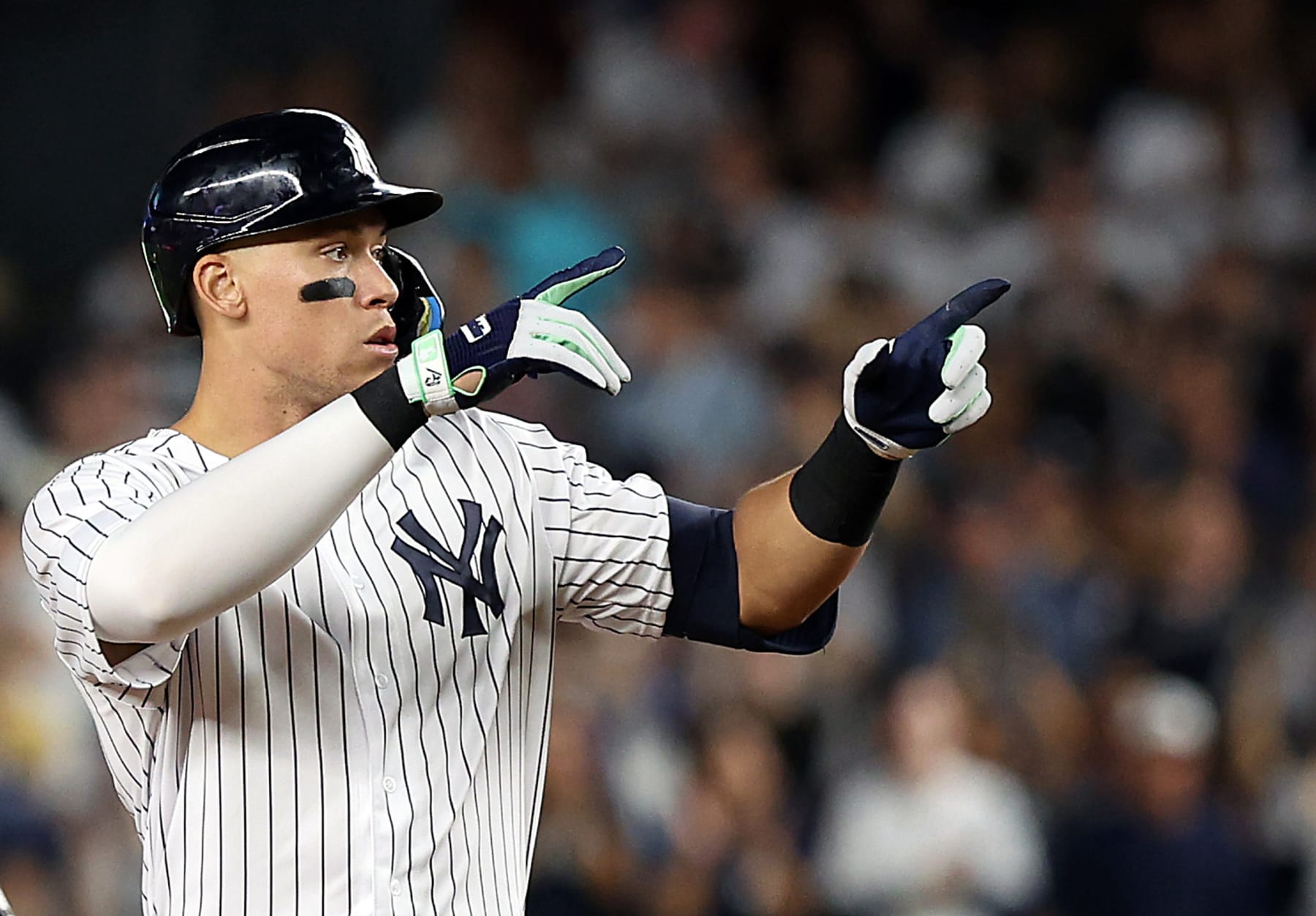
In the 75 years since Robinson first suited up for the Brooklyn Dodgers, Major League Baseball has only become more diverse as it has been infused with talent from all over the world. In the sense that it hasn't expanded since '98, the league is also pretty well settled.
As for whether Judge could be juicing, suffice it to say there are good reasons seemingly not a single soul actually thinks so.
He hasn't tested positive for anything, and he's about the last player on the planet who would need to even think about taking PEDs to get better at his job. At 6'7", 282 pounds, he's the biggest hitter in MLB history. Accordingly, he hits the ball harder than anyone in the sport.
Has Judge nonetheless benefited from playing his home games at Yankee Stadium, where the right field foul pole is famously just 314 feet away?
Yes, but not as much as you might think. The ever-useful Twitter account "Would it dong?" has flagged only two "unicorns"—that is, home runs that would be out at one stadium and nowhere else—for Judge at Yankee Stadium all year. Statcast puts his expected home runs at 61, indicating that his count is right where it ought to be.
If Judge was doing all this amid the extraordinary home run environments of 2017, 2019 or 2020, there would inevitably be talk of juiced balls. Home runs are down in 2022, however, precisely because there are new balls that aren't traveling as far.
There's also a compelling piece of circumstantial evidence that the ball isn't juiced.
If it was, one would expect Judge to have had company in his pursuit of home run history. In actuality, Philadelphia Phillies slugger Kyle Schwarber is his closest companion with a relatively paltry 46 home runs. Previously, a home run lead that large was known only to Ruth and Jimmie Foxx.
If Anything, Judge Is Disadvantaged
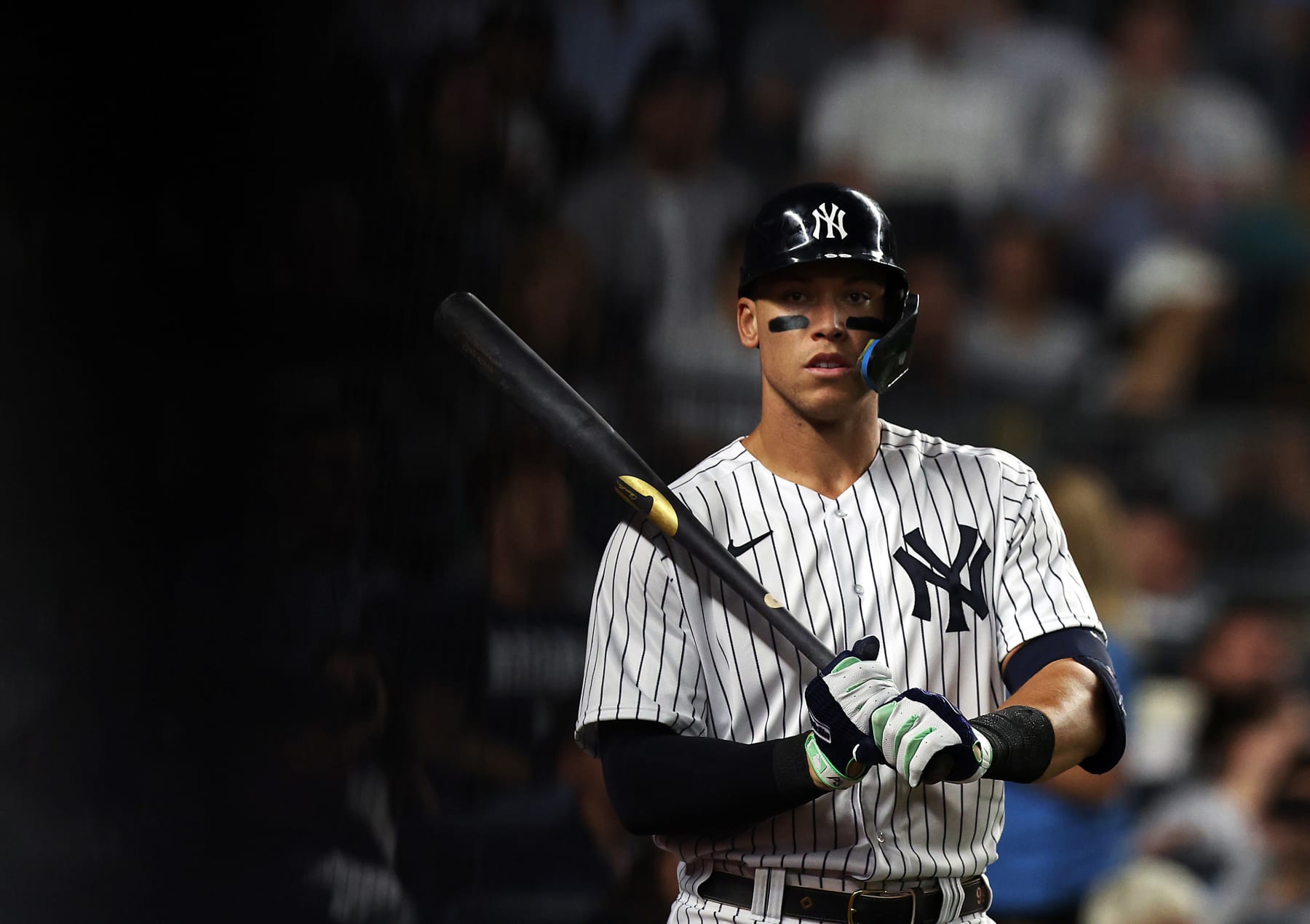
In addition to watered-down talent pools, PEDs and juiced balls, you know what else is advantageous for home run hitters?
Familiarity.
Hypothetically, the more times a batter sees a pitcher, the more likely they are to adjust to said pitcher. This is quantifiably true within games, as batters fare better against starting pitchers the more times they face them.
Nobody should be surprised to hear that this advantage doesn't apply nearly as much to Judge as it has to other members of the 60 Home Run Club. He's the first one to be stuck with a 60-40 split for his matchups against starters and relievers:
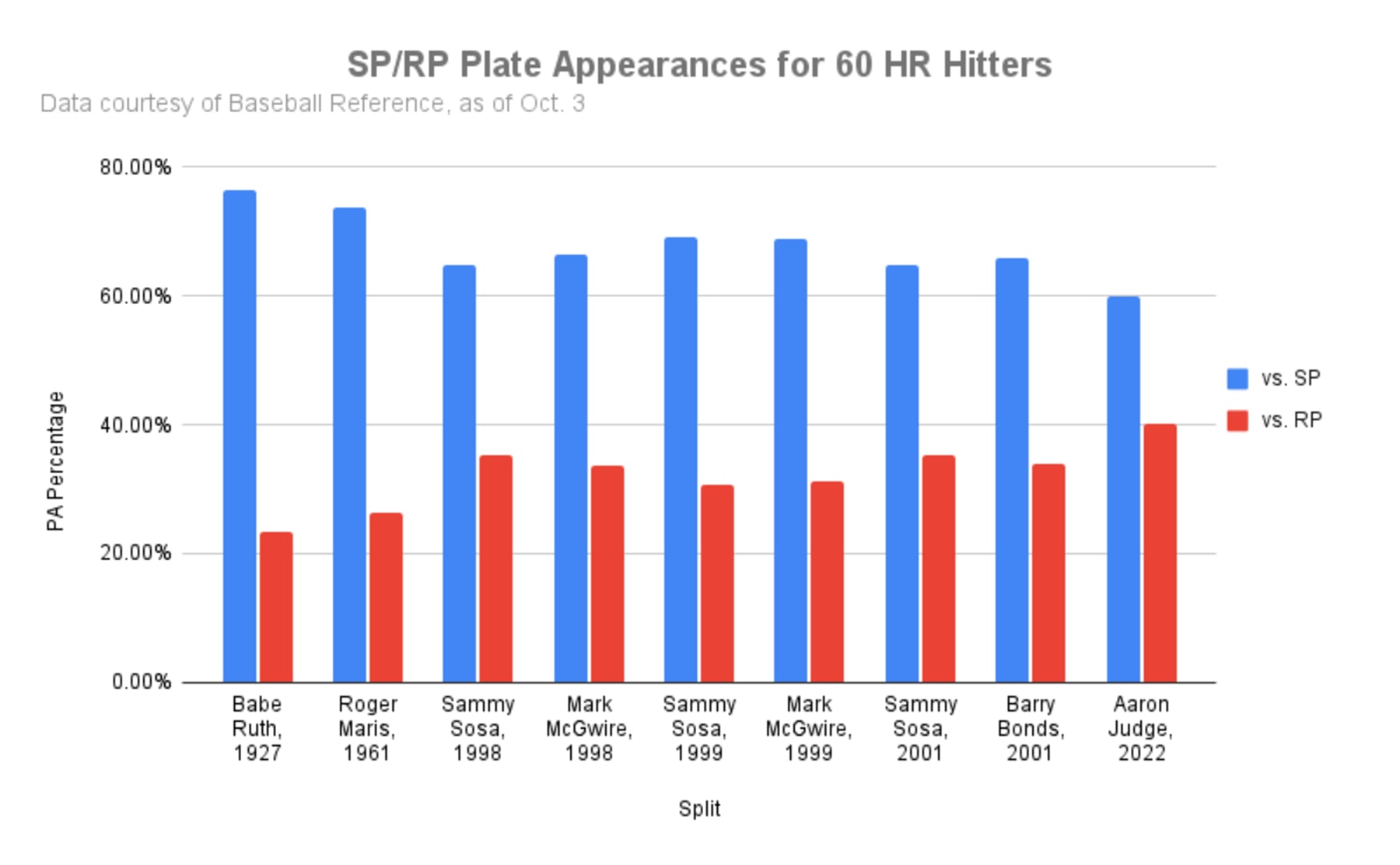
The difference is in how often Judge faces a reliever for the first time in a game in lieu of a starter for a third or fourth time. Those situations are the opposite of conducive to power hitting in 2022, as the average batter is slugging .446 in a third matchup against a starter and only .376 in a first matchup against a reliever.
This, in turn, also helps explain why Judge has seen so many more individual pitchers than any of the 60-homer players who came before him:
- Babe Ruth, 1927: 64 pitchers
- Roger Maris, 1961: 101 pitchers
- Sammy Sosa, 1998: 211 pitchers
- Mark McGwire, 1998: 201 pitchers
- Sammy Sosa, 1999: 215 pitchers
- Mark McGwire, 1999: 198 pitchers
- Sammy Sosa, 2001: 213 pitchers
- Barry Bonds, 2001: 205 pitchers
- Aaron Judge, 2022: 254 pitchers
And these 254 pitchers? They haven't taken it easy on Judge.
He's seen a higher rate of 95-plus mph fastballs (34.5 percent) than all but nine other hitters, and that's even as he's seen fewer fastballs on a rate basis (49.9 percent) than the average hitter (55.7 percent). Pitchers prefer to feed him sliders, aka the pitch against which he has the highest whiff rate (34.1 percent) out of the breaking ball family.
Did Ruth, Maris, McGwire, Sosa or Bonds face such nasty stuff on a day-to-day basis? Nobody can say for sure, but "no" is a safe guess.
Consider what things were like in 2008, the first year Statcast lists pitch-tracking data. The highest rate of 95-plus mph fastballs that any hitter saw that year was a mere 20.7 percent, while the whiff rate on the average slider was 3.7 percentage points lower than it is in 2022.
If that's what things were like 14 years ago, then it's hard to fathom hitters were facing as nasty or even nastier stuff in 2001. Or 1999. Or 1998. Or 1961. Or definitely 1927.
This is not to rule out the possibility that someone from the past could have hit 60-plus home runs in 2022. Take it from Baseball Reference's neutralized batting tool, which posits that '01 Bonds (69 HR) and '98 McGwire (64 HR) could have done so.
But as that's the end of the list, there's simply not enough to distract from the fact that only one person has actually topped 60 home runs in this year's environment.
For this, Judge can, should and indeed must take a bow.
Stats courtesy of Baseball Reference, FanGraphs and Baseball Savant.









